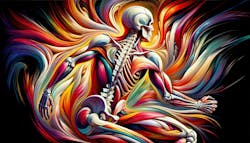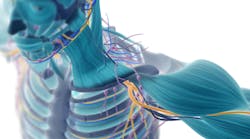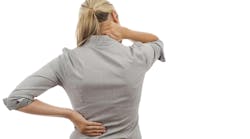Ergonomic safety in the dental office
It is well-documented that dental professionals are subject to the possibility of a multitude of work-related musculoskeletal disorders (WMSDs), often occurring early in their career.1 A WMSD is defined as an injury of the muscles, ligaments, nerves, cartilage, bones, or blood vessels in the arms, legs, neck, or back caused or aggravated by work tasks. Basic concerns should be the duration, frequency, and intensity of the posture during the performance of a work task, the activity being performed, and the motion that is needed to perform the task.
Risk factors
Physical risk factors causing musculoskeletal disorders (MSDs) include:
- Overuse, such as sustained or excessive force
- Overexertion, such as force bending, crouching, stretching, twisting, reaching, or stooping
- Strenuous activity, such as lifting heavy or bulky loads
- Repetitive motion, particularly with the same hand or arm
- Work with a display screen2
Physical risk factors are individual in nature. Each worker can react to similar risk factors with individual results. All workers have varying body structures, physical conditions, and past physical experiences.
Environmental risk factors include:
- Poor lighting
- Adverse or variant temperatures
- Noise levels
- Vibration
- Spatial relationship/room design2
Environmental risks often prove difficult to alter due to existing architectural or structural designs. Alternatively, simple changes may be possible with a courteous colleague conversation.
Psychosocial risk factors include:
- Lack of rest breaks
- Stress due to excessive work demands, such as high workload and tight deadlines
- Lack of control of the work and working methods
- Inability to make full use of skills
- Adverse relationships with colleagues or supervisors
Psychosocial factors are of concern as they may affect workers’ psychological responses to their work, workplace conditions, or workplace relationships. Stress-related changes of the body, such as increased muscle tension, can make individuals more susceptible to developing MSDs.3
Musculoskeletal pain
Though risk factors may be equal for all employees in a work environment, reactions to these risk factors can vary for each person. Musculoskeletal pain (MP) can be acute, meaning it is sudden and severe, or chronic (long-lasting). It can be localized pain (in one area of the body), or it may affect the entire body.4,5 MP can affect bones, joints, ligaments, muscles, tendons, bursas, or any combination.4
Tests used in the diagnosis of musculoskeletal pain can begin with x-rays and rheumatoid factor and antinuclear antibody blood tests, which are used to help diagnose common causes of arthritis. Further testing can include a magnetic resonance imaging (MRI) for the identification of abnormalities of soft tissues or a computed tomography (CT) scan to obtain more detail about a bone problem.5
Pain management of milder MSD pain can be relieved with over-the-counter medications, such as NSAIDs or acetaminophen; hot and cold therapies; strengthening, conditioning, and stretch exercises; and stress-reduction techniques.4 Treatment of MSDs will be more specific depending upon their actual underlying cause, but common treatments include pain relievers, acupuncture, chiropractic adjustment, occupational therapy, physical therapy, splints, steroid injections, and therapeutic massage.4,5
Signs versus symptoms
To reduce the risk for developing MSDs early in a dental career, it is imperative to understand the difference between a sign versus a symptom of a disease or disorder. A sign is any abnormality indicative of disease, discoverable on examination of the patient, or an objective indication of disease.6 It is the definite indication of the occurrence of a specific disease that is verifiable using diagnostic testing. In contrast, a symptom is a subjective indication of disease.7 It is any morbid departure from normal in structure or function experienced by a patient and indicative of disease, but it is only a vague report by a patient; something felt or experienced by a patient.7 Pain is the most common symptom of injury and disease, and descriptions can range in intensity from a mere ache to unbearable agony.8 Since signs of a disease or disorder are present long before symptoms occur, allowing the presence of pain to be the initial indicator to begin ergonomic intervention results in many years of lost preventive or intervention therapy.
Neutral posture
A very clear and straightforward approach to reducing the risk of developing MSDs is to practice neutral positioning during clinical and nonclinical activities. “Neutral posture is a manner of maintaining one’s body at a workstation in a relaxed position so that the joints are aligned and there is minimal stress on the tendons, muscles, and skeletal system. Neutral position is a posture in which stress on parts of the body is avoided.”9 Neutral posture varies depending on a standing or sitting position, but it is basically a posture with ears over the shoulder joint, shoulder over the hip joint, and hip joint over the ankles. The risk for developing MSDs diminishes as the stress put on the tendons, muscles, and skeletal system is lessened.
Benefits of an ergonomic safety program
Most MSDs are preventable. Establishing a strong safety discipline in dental practices can have significant effects on injury costs. Creating an in-office ergonomic safety program makes smart business sense. A good ergonomic safety program saves more than it costs and maximizes productivity by focusing on reducing worker injury, errors, and absenteeism. An educated businessperson knows that workers are the main cost for modern businesses. Patients and the dental practice both benefit from attracting and maintaining the best talent available.
Topics for ergonomic safety could include implementing a team stretching or walking program, improving instrument sharpening skills or investigating a sharpening membership program, establishing an ergonomic photo buddy system, considering a professional in-
office ergonomic assessment, or reviewing the return on investment with the purchase of up-to-date ergonomic personal protective equipment for the entire staff.
A heightened ergonomic culture for dental personnel can ease the financial burden that MSDs cost the health-care industry in workers’ compensation claims per year, as well as diminish the unnecessary misery and suffering inflicted upon affected workers and, consequently, the entire dental practice.
Editor's note: This article appeared in the October 2024 print edition of RDH magazine. Dental hygienists in North America are eligible for a complimentary print subscription. Sign up here.
References
- Lietz J, Ulusoy N, Nienhaus A. Prevention of musculoskeletal diseases and pain among dental professionals through ergonomic interventions: a systematic literature review. Int J Environ Res Public Health. 2020;17(10):3482. doi:3390/ijerph17103482
- Managing musculoskeletal disorders risk at work. Health and Safety Executive. Accessed June 28, 2024. https://www.hse.gov.uk/msd/msds.htm
- What are psychosocial risk factors? Health and Safety Executive. Accessed June 28, 2024. https://www.hse.gov.uk/msd/mac/psychosocial.htm
- Musculoskeletal pain. Cleveland Clinic. Reviewed March 10, 2021. Accessed January 7, 2022. https://my.clevelandclinic.org/health/diseases/14526-musculoskeletal-pain
- Villa-Forte A. Musculoskeletal pain. Merck Manual Consumer Version. Updated February 2023. Accessed January 7, 2022. https://www.merckmanuals.com/home/bone,-joint,-and-muscle-disorders/symptoms-of-musculoskeletal-disorders/musculoskeletal-pain
- Definition of “sign.” The Free Dictionary. Accessed January 5, 2022. https://medical-dictionary.thefreedictionary.com/sign
- Definition of “symptom.” The Free Dictionary. Accessed January 5, 2022. https://medical-dictionary.thefreedictionary.com/symptom
- Definition of “pain.” The Free Dictionary. Accessed January 5, 2022. https://medical-dictionary.thefreedictionary.com/pain
- Neutral position. Sure Hire Occupational Testing. Accessed June 29, 2024. https://us.surehire.com/resources/dictionary/terms/?=Neutral%20Position
About the Author

Cindy M. Purdy, BSDH, RDH, CEAS
Cindy M. Purdy, BSDH, RDH, CEAS, has a passion for workplace wellness that has resulted in the creation of THRIVE, a dental-oriented wellness and therapeutic alternatives summit for dental professionals. THRIVE occurs three to four times annually at Glen Eyrie Castle in Colorado Springs, Colorado. Attendance information can be found at cindypurdy.com. In addition to multiple decades as a clinical dental hygienist, Cindy holds an ergonomic certification from Colorado State University, a certified ergonomic assessment specialist credential, and is certified in health-care ergonomics.


